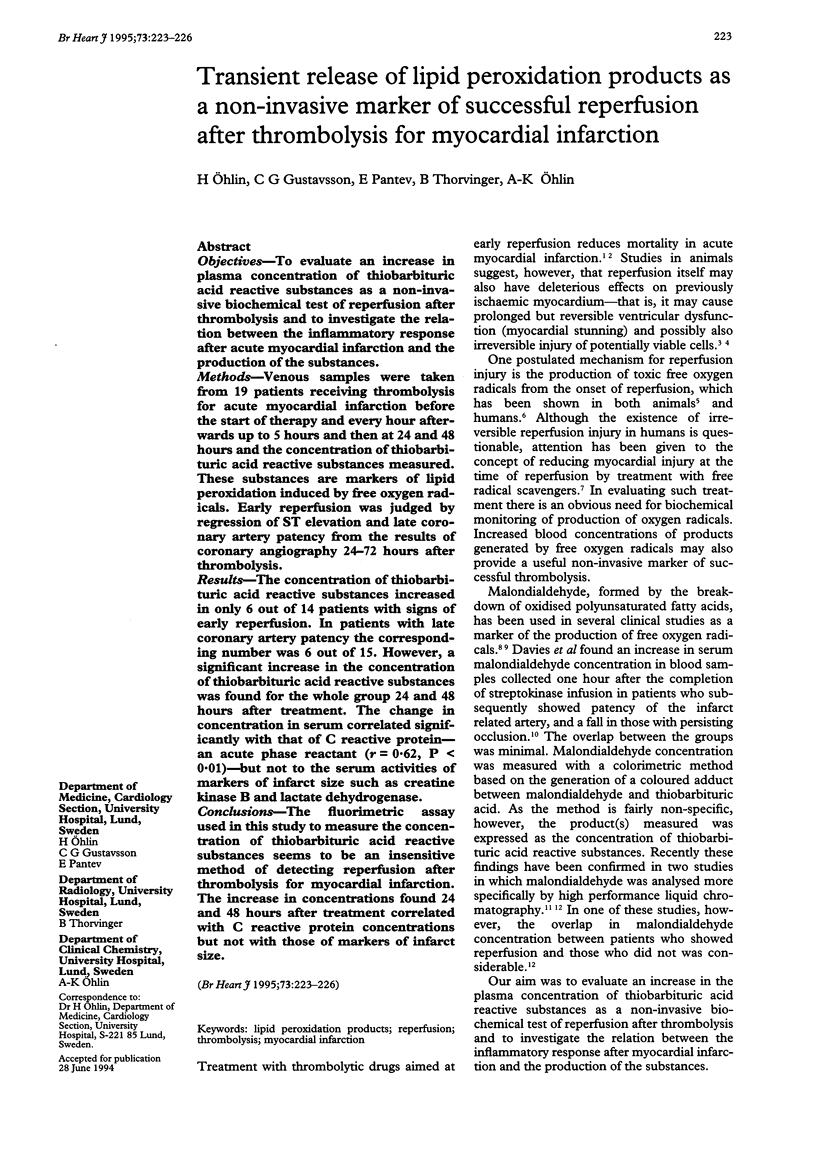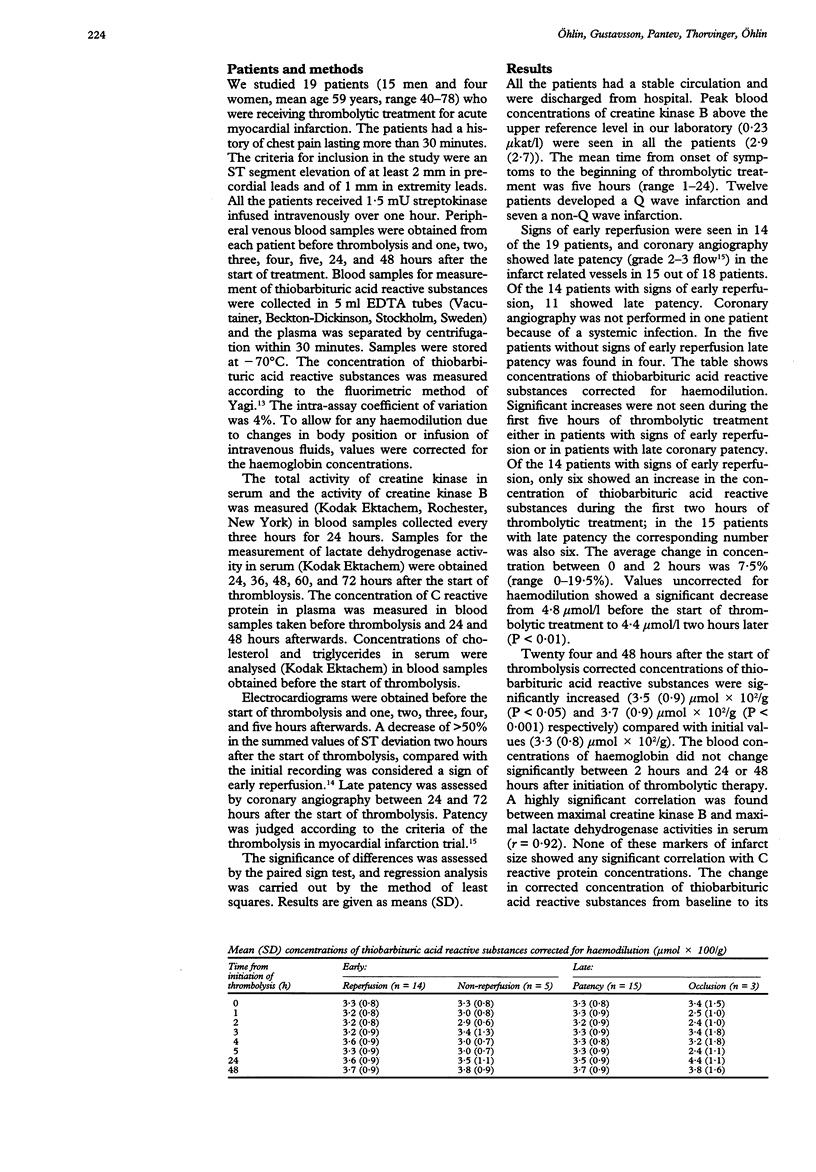Abstract
OBJECTIVES--To evaluate an increase in plasma concentration of thiobarbituric acid reactive substances as a non-invasive biochemical test of reperfusion after thrombolysis and to investigate the relation between the inflammatory response after acute myocardial infarction and the production of the substances. METHODS--Venous samples were taken from 19 patients receiving thrombolysis for acute myocardial infarction before the start of therapy and every hour afterwards up to 5 hours and then at 24 and 48 hours and the concentration of thiobarbituric acid reactive substances measured. These substances are markers of lipid peroxidation induced by free oxygen radicals. Early reperfusion was judged by regression of ST elevation and late coronary artery patency from the results of coronary angiography 24-72 hours after thrombolysis. RESULTS--The concentration of thiobarbituric acid reactive substances increased in only 6 out of 14 patients with signs of early reperfusion. In patients with late coronary artery patency the corresponding number was 6 out of 15. However, a significant increase in the concentration of thiobarbituric acid reactive substances was found for the whole group 24 and 48 hours after treatment. The change in concentration in serum correlated significantly with that of C reactive protein--an acute phase reactant (r = 0.62, P < 0.01)--but not to the serum activities of markers of infarct size such as creatine kinase B and lactate dehydrogenase. CONCLUSIONS--The fluorimetric assay used in this study to measure the concentration of thiobarbituric acid reactive substances seems to be an insensitive method of detecting reperfusion after thrombolysis for myocardial infarction. The increase in concentrations found 24 and 48 hours after treatment correlated with C reactive protein concentrations but not with those of markers of infarct size.
Full text
PDF



Selected References
These references are in PubMed. This may not be the complete list of references from this article.
- Barbash G. I., Roth A., Hod H., Miller H. I., Rath S., Har-Zahav Y., Modan M., Seligsohn U., Battler A., Kaplinsky E. Rapid resolution of ST elevation and prediction of clinical outcome in patients undergoing thrombolysis with alteplase (recombinant tissue-type plasminogen activator): results of the Israeli Study of Early Intervention in Myocardial Infarction. Br Heart J. 1990 Oct;64(4):241–247. doi: 10.1136/hrt.64.4.241. [DOI] [PMC free article] [PubMed] [Google Scholar]
- Bolli R., Patel B. S., Jeroudi M. O., Lai E. K., McCay P. B. Demonstration of free radical generation in "stunned" myocardium of intact dogs with the use of the spin trap alpha-phenyl N-tert-butyl nitrone. J Clin Invest. 1988 Aug;82(2):476–485. doi: 10.1172/JCI113621. [DOI] [PMC free article] [PubMed] [Google Scholar]
- Braunwald E., Kloner R. A. Myocardial reperfusion: a double-edged sword? J Clin Invest. 1985 Nov;76(5):1713–1719. doi: 10.1172/JCI112160. [DOI] [PMC free article] [PubMed] [Google Scholar]
- Braunwald E., Kloner R. A. The stunned myocardium: prolonged, postischemic ventricular dysfunction. Circulation. 1982 Dec;66(6):1146–1149. doi: 10.1161/01.cir.66.6.1146. [DOI] [PubMed] [Google Scholar]
- Brown E. J., Jr, Kloner R. A., Schoen F. J., Hammerman H., Hale S., Braunwald E. Scar thinning due to ibuprofen administration after experimental myocardial infarction. Am J Cardiol. 1983 Mar 1;51(5):877–883. doi: 10.1016/s0002-9149(83)80148-9. [DOI] [PubMed] [Google Scholar]
- Chesebro J. H., Knatterud G., Roberts R., Borer J., Cohen L. S., Dalen J., Dodge H. T., Francis C. K., Hillis D., Ludbrook P. Thrombolysis in Myocardial Infarction (TIMI) Trial, Phase I: A comparison between intravenous tissue plasminogen activator and intravenous streptokinase. Clinical findings through hospital discharge. Circulation. 1987 Jul;76(1):142–154. doi: 10.1161/01.cir.76.1.142. [DOI] [PubMed] [Google Scholar]
- Davies S. W., Ranjadayalan K., Wickens D. G., Dormandy T. L., Timmis A. D. Lipid peroxidation associated with successful thrombolysis. Lancet. 1990 Mar 31;335(8692):741–743. doi: 10.1016/0140-6736(90)90866-4. [DOI] [PubMed] [Google Scholar]
- Ellis A. K., Little T., Zaki Masud A. R., Klocke F. J. Patterns of myoglobin release after reperfusion of injured myocardium. Circulation. 1985 Sep;72(3):639–647. doi: 10.1161/01.cir.72.3.639. [DOI] [PubMed] [Google Scholar]
- Engler R., Covell J. W. Granulocytes cause reperfusion ventricular dysfunction after 15-minute ischemia in the dog. Circ Res. 1987 Jul;61(1):20–28. doi: 10.1161/01.res.61.1.20. [DOI] [PubMed] [Google Scholar]
- Fechner J., Goy J., Artigou J. Y., Bedu O., Loeper J., Emerit J., Grosgogeat Y. Etude de la peroxydation lipidique membranaire au cours de l'insuffisance coronaire. Presse Med. 1986 Jun 7;15(23):1077–1080. [PubMed] [Google Scholar]
- Garabedian H. D., Gold H. K., Yasuda T., Johns J. A., Finkelstein D. M., Gaivin R. J., Cobbaert C., Leinbach R. C., Collen D. Detection of coronary artery reperfusion with creatine kinase-MB determinations during thrombolytic therapy: correlation with acute angiography. J Am Coll Cardiol. 1988 Apr;11(4):729–734. doi: 10.1016/0735-1097(88)90204-5. [DOI] [PubMed] [Google Scholar]
- Garlick P. B., Davies M. J., Hearse D. J., Slater T. F. Direct detection of free radicals in the reperfused rat heart using electron spin resonance spectroscopy. Circ Res. 1987 Nov;61(5):757–760. doi: 10.1161/01.res.61.5.757. [DOI] [PubMed] [Google Scholar]
- Giardina B., Penco M., Lazzarino G., Romano S., Tavazzi B., Fedele F., Di Pierro D., Dagianti A. Effectiveness of thrombolysis is associated with a time-dependent increase of malondialdehyde in peripheral blood of patients with acute myocardial infarction. Am J Cardiol. 1993 Apr 1;71(10):788–793. doi: 10.1016/0002-9149(93)90825-w. [DOI] [PubMed] [Google Scholar]
- Gryglewski R. J., Palmer R. M., Moncada S. Superoxide anion is involved in the breakdown of endothelium-derived vascular relaxing factor. Nature. 1986 Apr 3;320(6061):454–456. doi: 10.1038/320454a0. [DOI] [PubMed] [Google Scholar]
- Halliwell B., Hoult J. R., Blake D. R. Oxidants, inflammation, and anti-inflammatory drugs. FASEB J. 1988 Oct;2(13):2867–2873. doi: 10.1096/fasebj.2.13.2844616. [DOI] [PubMed] [Google Scholar]
- Jugdutt B. I., Basualdo C. A. Myocardial infarct expansion during indomethacin or ibuprofen therapy for symptomatic post infarction pericarditis. Influence of other pharmacologic agents during early remodelling. Can J Cardiol. 1989 May;5(4):211–221. [PubMed] [Google Scholar]
- Ledwozyw A., Michalak J., Stepień A., Kadziołka A. The relationship between plasma triglycerides, cholesterol, total lipids and lipid peroxidation products during human atherosclerosis. Clin Chim Acta. 1986 Mar 28;155(3):275–283. doi: 10.1016/0009-8981(86)90247-0. [DOI] [PubMed] [Google Scholar]
- Pietilä K., Harmoinen A., Hermens W., Simoons M. L., Van de Werf F., Verstraete M. Serum C-reactive protein and infarct size in myocardial infarct patients with a closed versus an open infarct-related coronary artery after thrombolytic therapy. Eur Heart J. 1993 Jul;14(7):915–919. doi: 10.1093/eurheartj/14.7.915. [DOI] [PubMed] [Google Scholar]
- Romson J. L., Hook B. G., Kunkel S. L., Abrams G. D., Schork M. A., Lucchesi B. R. Reduction of the extent of ischemic myocardial injury by neutrophil depletion in the dog. Circulation. 1983 May;67(5):1016–1023. doi: 10.1161/01.cir.67.5.1016. [DOI] [PubMed] [Google Scholar]
- Sato Y., Hotta N., Sakamoto N., Matsuoka S., Ohishi N., Yagi K. Lipid peroxide level in plasma of diabetic patients. Biochem Med. 1979 Feb;21(1):104–107. doi: 10.1016/0006-2944(79)90061-9. [DOI] [PubMed] [Google Scholar]
- Schimke I., Kahl P. E., Romaniuk P., Papies B. Konzentration Thiobarbitursäure-reaktiver Substanzen (TBARS) im Serum nach Myokardinfarkt. Klin Wochenschr. 1986 Dec 1;64(23):1237–1239. doi: 10.1007/BF01734466. [DOI] [PubMed] [Google Scholar]
- Young I. S., Purvis J. A., Lightbody J. H., Adgey A. A., Trimble E. R. Lipid peroxidation and antioxidant status following thrombolytic therapy for acute myocardial infarction. Eur Heart J. 1993 Aug;14(8):1027–1033. doi: 10.1093/eurheartj/14.8.1027. [DOI] [PubMed] [Google Scholar]
- Young I. S., Purvis J. A., Lightbody J. H., Adgey A. A., Trimble E. R. Lipid peroxidation and antioxidant status following thrombolytic therapy for acute myocardial infarction. Eur Heart J. 1993 Aug;14(8):1027–1033. doi: 10.1093/eurheartj/14.8.1027. [DOI] [PubMed] [Google Scholar]


